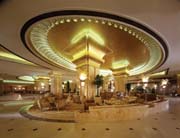
“It is difficult to give an apt description to the Emirates Palace. String together a host of superlative adjectives, and somehow you still feel that you have fallen short of the mark.†These were the words written by the publicity department at the Emirates Palace in Abu Dhabi, United Arab Emirates, and they are quite accurate. The project spans approximately 1 kilometer from end to end, and includes a luxury hotel, the region's largest conference center, 12 upscale restaurants, high-end retail locations, two spas and other amenities. As one might expect from such a project, the Emirates Palace is highlighted by an impressive array of stonework, including American granite on the exterior.
The Emirates Palace is owned by the Government of Abu Dhabi, and the Kempinski Group was chosen to operate the facility. As the oldest European luxury hotel group, Kempinski has vast experience in managing legendary properties such as the Adlon in Berlin, Germany; Ciragan Palace in Istanbul, Turkey; Grand Hotel Europe in St. Petersburg, Russia; and the Leela Palaces in India, to name a few.
The architecture firm for the Emirates Palace is Wimberly Allison Tong and Goo (WATG), one of the leading hospitality designers worldwide. The firm, which has offices around the world, has designed some of the world's finest hotels, including the Atlantis on Paradise Island, the Bahamas; The Venetian Resort Hotel and Casino in Las Vegas and the Hotel Bora Bora, among others. “The design challenge was to create the finest example of a grand civic building in the United Arab Emirates,†according to WATG, which said its design solution “blends traditional materials and motifs with the latest technology.â€
The exterior architecture of the Emirates Palace incorporates traditional Arabian elements such as the grand dome and 114 smaller domes spread over the building. The colors of the facade represent the different sand nuances found in the Arabian Desert. A predominant exterior material is Salisbury Pink granite, which was quarried in North Carolina by Rock of Ages. “We quarried 1,800 cubic meters for this project over a period of four months,†explained Bob Campo of Rock of Ages. “The blocks were sent to Italy, where fabrication was done at both the Savema and Campolonghi factories.â€
A full complement of machinery at Campolonghi was used to fabricate the stonework for the Emirates Palace, including gangsaws, bridge saws, wire saws and a range of CNC equipment. Machinery used at Campolonghi's plant included equipment from Pellegrini, GMM and Omag, among others.
The interior design of the Palace is by KY&A, which specializes in hotel, resort and spa interiors, and has completed the interior design of major five-star hotels in locations such as Thailand, Malaysia, China, Singapore, India and Nepal. Stonework for the interior of the Emirates Palace includes a range of materials for the public spaces, lounges and guest rooms/suites. Materials came from around the world, including some stones taken from quarries that were re-opened specifically to supply stone for the Emirates Palace.
In all, it is approximately a 2.5-kilometer walk around Emirates Palace. The hotel features 302 luxury rooms and 92 suites, while the conference facilities include an auditorium with 1,200 seats, a main ballroom that can accommodate up to 2,800 guests, and an extensive range of over 40 meeting rooms.
The primary market segments targeted by the Emirates Palace include official government visits and events; international conferences; high-end leisure and corporate functions. The Emirates Palace employs around 2,000 staff members representing approxi-mately 50 nationalities.
It took a work force of approximately 12,000 people to complete all phases of the Palace's construction. Construction began in December 2001, and the Emirates Palace opened its gates in February 2005.